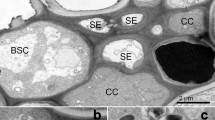Abstract
Sugar transport in the phloem is driven by turgor pressure gradients which are created by osmotic gradients resulting from sugars loaded to the phloem at the source tissue and unloaded at the sink tissue. Therefore, osmolality is a key parameter that can be used to evaluate sugar status and get an indication of the driving force for phloem transport. Here we describe how osmotic concentration measurements from inner bark (practically, the phloem) and needles of trees can be measured. This protocol presents the procedure used by Lintunen et al. (Front Plant Sci 7:726, 2016) and Paljakka et al. (Plant Cell Environ 40:2160–2173, 2017), extended by practical advice and discussion of potential errors and caveats. We describe how to implement this procedure for gymnosperm as well as angiosperm trees. This method uses mechanical sap extraction with a centrifuge from inner bark and leaf samples, which have gone through a deep freeze treatment and thawing. The osmotic potential of these samples is then analyzed with a freezing point or vapor pressure osmometer. The aim of these measurements is to study the spatial and temporal dynamics of phloem function.
Access this chapter
Tax calculation will be finalised at checkout
Purchases are for personal use only
Similar content being viewed by others
References
Münch E (1930) Die Stoffbewegungen in der Pflanze. Gustav Fischer, Jena, pp 124–146
Liesche J, Schulz A (2018) Phloem transport in gymnosperms: a question of pressure and resistance. Curr Opin Plant Biol 43:36–42
Nobel PS (2005) Physiochemical and environmental plant physiology, 3rd edn. WH Freeman and Company, New York
Quentin AG, Pinkard EA, Ryan MG, Tissue DT, Baggett LS, Adams HD et al (2015) Non-structural carbohydrates in woody plants compared among laboratories. Tree Physiol 35(11):1146–1165
Rosner S, Baier P, Kikuta SB (2001) Osmotic potential of Norway spruce [Picea abies (L.) Karst.] secondary phloem in relation to anatomy. Trees 15(8):472–482
Sovonick-Dunford S, Lee DR, Zimmermann MH (1981) Direct and indirect measurements of phloem turgor pressure in white ash. Plant Physiol 68(1):121–126
van Bel AJ (2003) The phloem, a miracle of ingenuity. Plant Cell Environ 26(1):125–149
Kaufmann MR, Kramer PJ (1967) Phloem water relations and translocation. Plant Physiol 42(2):191–194
Devaux M, Ghashghaie J, Bert D, Lambrot C, Gessler A, Bathellier C et al (2009) Carbon stable isotope ratio of phloem sugars in mature pine trees throughout the growing season: comparison of two extraction methods. Rapid Commun Mass Spectrom 23(16):2511–2518
Huttunen S, Kärenlampi L, Kolari K (1981) Changes in osmotic potential and some related physiological variables in needles of polluted Norway spruce (Picea abies). In: Annales Botanici Fennici. Finnish Botanical Publishing Board, New York, NY, pp 63–71
Irvine J, Perks MP, Magnani F, Grace J (1998) The response of Pinus sylvestris to drought: stomatal control of transpiration and hydraulic conductance. Tree Physiol 18(6):393–402
Scholander PF, Hammel HT, Hemmingsen EA, Bradstreet ED (1964) Hydrostatic pressure and osmotic potential in leaves of mangroves and some other plants. Proc Natl Acad Sci U S A 52(1):119–125
Jyske T, Hölttä T (2015) Comparison of phloem and xylem hydraulic architecture in Picea abies stems. New Phytol 205(1):102–115
Lintunen A, Paljakka T, Jyske T, Peltoniemi M, Sterck F, Von Arx G et al (2016) Osmolality and non-structural carbohydrate composition in the secondary phloem of trees across a latitudinal gradient in Europe. Front Plant Sci 7:726. https://doi.org/10.3389/fpls.2016.00726
Paljakka T, Jyske T, Lintunen A, Aaltonen H, Nikinmaa E, Hölttä T (2017) Gradients and dynamics of inner bark and needle osmotic potentials in Scots pine (Pinus sylvestris L.) and Norway spruce (Picea abies (L.) Karst). Plant Cell Environ 40(10):2160–2173. https://doi.org/10.1111/pce.13017
Salmon Y, Torres-Ruiz JM, Poyatos R, Martinez-Vilalta J, Meir P, Cochard H, Mencuccini M (2015) Balancing the risks of hydraulic failure and carbon starvation: a twig scale analysis in declining Scots pine. Plant Cell Environ 38(12):2575–2588
Takami S, Turner NC, Rawson HM (1981) Leaf expansion of four sunflower (Helianthus annuus L) cultivars in relation to water deficits. I. Patterns during plant development. Plant Cell Environ 4(5):399–407
Smart RE, Bingham GE (1974) Rapid estimates of relative water content. Plant Physiol 53(2):258–260
Hölttä T, Vesala T, Sevanto S, Perämäki M, Nikinmaa E (2006) Modeling xylem and phloem water flows in trees according to cohesion theory and Münch hypothesis. Trees 20(1):67–78
Author information
Authors and Affiliations
Corresponding author
Editor information
Editors and Affiliations
Rights and permissions
Copyright information
© 2019 Springer Science+Business Media, LLC, part of Springer Nature
About this protocol
Cite this protocol
Paljakka, T., Lintunen, A., Salmon, Y., Hölttä, T. (2019). Measurement of Inner Bark and Leaf Osmolality. In: Liesche, J. (eds) Phloem. Methods in Molecular Biology, vol 2014. Humana, New York, NY. https://doi.org/10.1007/978-1-4939-9562-2_11
Download citation
DOI: https://doi.org/10.1007/978-1-4939-9562-2_11
Published:
Publisher Name: Humana, New York, NY
Print ISBN: 978-1-4939-9561-5
Online ISBN: 978-1-4939-9562-2
eBook Packages: Springer Protocols




